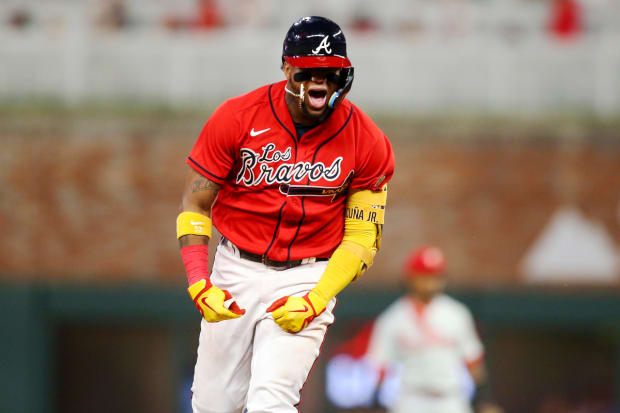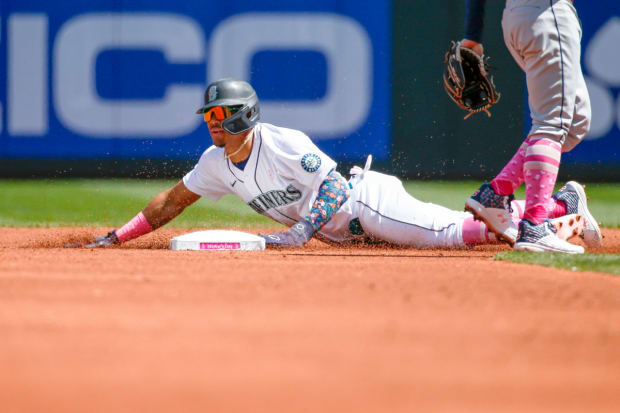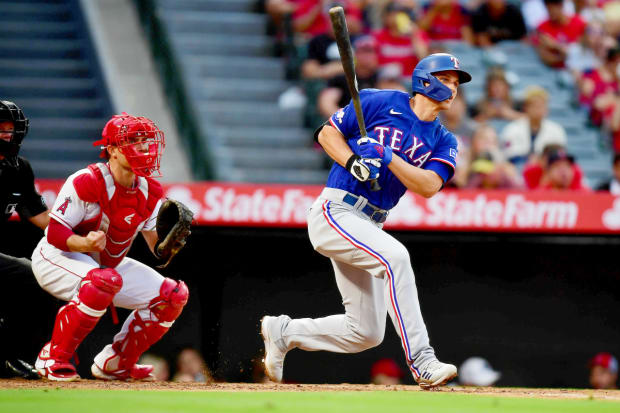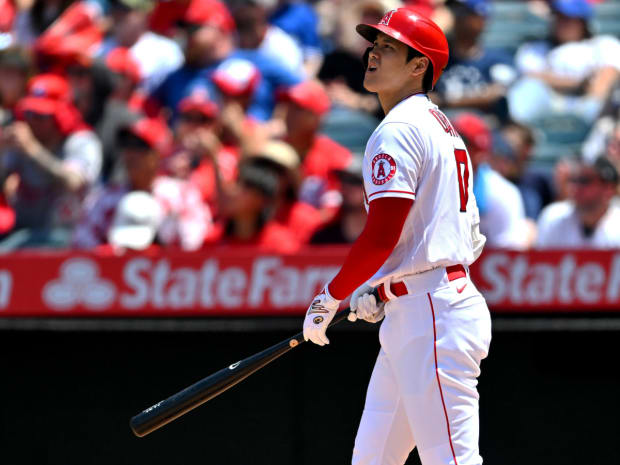Welcome to 2023, a joyful year when it comes to math and baseball. The number 2023 is a Harshad number, a term from Sanskrit that means “joy-giver.” A Harshad number is any number that is divisible by the sum of its digits (2 + 0 + 2 + 3 = 7; 2023 / 7 = 289). This is the first time since 2000 and ’01 that we get back-to-back years with Harshad numbers. With two more to follow, it is the first four-year Harshad run since 1014 to ’17—not even Rich Hill was pitching in the High Middle Ages—and the last until 3030 to ’33.
It’s also a Harshad baseball season because new rules are joy-givers. MLB games for the first time will be played with a pitch timer and specific governors on where defenders must stand. Hallelujah.
A countdown clock between pitches and regulations for where defenders can be positioned were antithetical to the game’s free-market traditions for about a hundred years. But because players took too long, and because shifts took away too many hits, what was once charming became corrosive. Proven in the minors, and with the addition of bigger bases, the new rules are designed to bring back a better version of baseball: faster paced with more balls in play and more stolen bases. Joy, joy.
What can we expect from this whole new ballgame? Here are 15 predictions to ring in 2023. Happy Harshad.

Brett Davis-USA TODAY Sports
1. The average time of game will be cut by 20 minutes—down to 2 hours, 46 minutes, the quickest since 1985.
The pitch timer in the minors last season shaved 25 minutes off average game time with limits between pitches of 14 seconds with the bases empty and 19 with runners. The MLB timer allows 15 and 20 seconds, respectively.
2. Pitchers and hitters will complain in April.
You can write the stories now: Counts, at bats and even games will be changed because of pitch timer violations. Players will bellyache about being “rushed” and about the penalty (a ball or strike added to the count) being too severe. Imagine the first time a batter is assessed a third strike for dallying.
But after a month or so the complaints will dissipate, and the new normal pace of game will be established—just as happened with the slide rule at second base, the anti-collision rule at home plate and the minor league adoption of the pitch timer. Violations in the minors last year started at 1.73 per game in Week 2 and dropped to 0.73 in Week 5—and by Week 21 it stabilized at 0.45, or about one violation every two games.
The pitchers with the most difficulty adjusting will be veterans accustomed to taking more time between pitches and those who have slow deliveries to the plate. Those facing the biggest adjustment include relievers Giovanny Gallegos of the Cardinals, Kenley Jansen of the Red Sox, Craig Kimbrel of the Phillies, Adam Ottavino of the Mets and Devin Williams of the Brewers, and starters Sandy Alcantara of the Marlins, Kevin Gausman of the Blue Jays, Frankie Montas of the Yankees and Noah Syndergaard of the Dodgers. Also keep an eye on the Blue Jays’ Chris Bassitt, who loves to freeze a hitter by shaking through multiple signs, and the Mets’ Max Scherzer, who has a poor pickoff move (no pickoffs since 2016) but has learned how to defend the running game by long holds from the set a position, a technique that is reduced by the timer. He must come set much earlier if he wants to use a similar tactic.
Hitters must be in the box and ready to hit with eight seconds on the timer. The hitters with routines most affected by the timer include Pete Alonso and Mark Canha of the Mets, Bryce Harper of the Phillies, J.D. Martinez of the Dodgers and Christian Vázquez of the Twins.

Joe Nicholson/USA TODAY Sports
3. Stolen base attempts will increase to their highest level since 2012.
Bigger bases and a limit on pickoff attempts will encourage more attempts. Stolen base attempts in the minors jumped 27% from 2019 to ’22 with the same rules.
4. The number of 30–30 players will increase from zero last season to seven, breaking the record of four in 1987, ’96, ’97 and 2011.
The 30–30 club: Ronald Acuña Jr. of the Braves, Adolis García of the Rangers, Julio Rodríguez of the Mariners, Fernando Tatis Jr. of the Padres, Kyle Tucker of the Astros, Trea Turner of the Phillies and Bobby Witt Jr. of the Royals.
5. Carlos Correa will sign a contract with the Mets.
It could include narrow language to reduce the team’s risk—like the protection Boston negotiated with J.D. Martinez concerning a past foot injury. Boston could have opted out of the fourth and fifth years if Martinez missed a combined 120 days in years two and three (with at least 10 days in year three) due specifically to the known issue. Like the Giants, the Mets have expressed concern about a lower leg/ankle fracture Correa suffered in 2014.
6. Corey Seager of Texas, Matt Olson of Atlanta and Juan Soto of San Diego will be the hitters most positively affected by the bans against shifts, deep infield positioning and four-outfielder alignments.

Gary A. Vasquez/USA TODAY Sports
7. The MLB batting average will rise from .243 in 2022 (worst since the mound was lowered in 1969) to .254 (best since ’17).
About 2,500 hits will be restored to the baseball season.
8. Jon Berti of the Marlins and Trea Turner will become the first players in six years to steal 50 bases.
Every postseason team will carry an elite runner on the bench. With the stolen base success rate nudging up a few percentage points, the threat of a stolen bases in a big spot will again heighten postseason drama. Last year in this risk-averse game, stolen bases per game dropped 17% in the postseason compared to the regular season.
9. Without shifts, the Dodgers will not lead the league in ERA for a fifth straight year.
That title will return to Houston. Los Angeles president Andrew Friedman, the wizard of shifts, loses his 15-year edge on other clubs with the new rules. From 2008 to ’14, when he was general manager of the Rays, Tampa Bay led the majors in lowest BABIP (.273); then from ’15 to ’22 his Dodgers led the majors (.272).
10. Despite months of speculation, Shohei Ohtani will not be traded at the deadline.
New owners of the Angels, with the team hanging around a wild-card spot, make every attempt to keep the game’s most lucrative asset.

Jayne Kamin-Oncea/USA TODAY Sports
11. Righthanders Grayson Rodriguez of the Orioles and Andrew Painter of the Phillies will contend for Rookie of the Year honors. Only one true starter is among the past 16 winners of the award (Michael Fullmer in 2016). Both tall righthanders will have the opportunity.
12. Speaking of tall, hard-throwing righthanders Tyler Glasnow of the Rays and Dustin May of the Dodgers will be Comeback Players of the Year.
13. Adrián Beltré will be the headliner (and first-ballot electee) on the December Hall of Fame ballot, following fellow third baseman Scott Rolen into Cooperstown.
Beltré and Rolen were the starting third basemen in the 2011 All-Star Game. Beltré (93.5) and Rolen (70.1) have the highest WAR of any third basemen not yet in Cooperstown (min. 75% games played at third base).
14. Two losing teams from 2022 are going to the playoffs in ’23.
We know this because 64 teams in 28 seasons in the wild-card era have pulled off this turnaround—including at least one such turnaround team 17 years in a row and 27 out of 28. The best bets this year: the Diamondbacks and Rangers.
15. The World Series teams will be …
The Mets are the favorite when it comes to payroll. What does that mean? Not much over the past 13 years, when the team with the highest payroll has won the World Series twice (2018 Red Sox and ’20 Dodgers) and lost it once (’17 Dodgers). It missed the postseason twice and was knocked out in the LDS four times and in the LCS four times.
The average World Series matchup over the past 13 years has been the No. 8 payroll against the No. 13 payroll:
World Series Teams Average Payroll Rank, 2010–22
Winner: 8.2
Loser: 12.9
Under that trend, the Braves will be playing the Red Sox in the World Series. But that disregards how much baseball has changed in more recent years. As the gap widens between the haves and have-nots, payroll matters more. The No. 1 payroll team has reached the World Series three times in the past six years, while the likelihood of a team from outside the top 10 in payroll reaching the World Series is a fraction of what it was seven years ago:
Top 10 Payroll Teams in World Series
2010–16: 3 of 14 playoff teams (21%)
2017–22: 10 of 12 playoff teams (83%)
With the more money-driven modern game in mind, let’s find the most likely payroll rankings for pennant winners of the past six years:
World Series Teams Average Payroll Rank, 2017–22
Winner: 7.3
Loser: 8.3
Applying this math, here is your too-early 2023 World Series call: Blue Jays over Braves.







